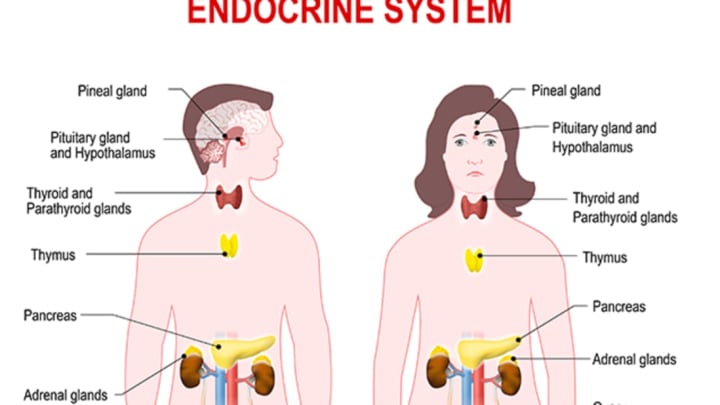Hormones get a bad rap for a variety of conditions, from the rapid, awkward changes we experience at puberty to the mood swings associated with premenstrual syndrome. But without them, we’d never grow, have libidos, or reproduce, to name just a few key human experiences.
They also play a role in a wide range of essential functions in the body. The collection of glands that produce most hormones are known as the endocrine system. Though tiny in size, these glands do everything from regulating your metabolism and allowing you to sleep to initiating labor. Though each gland has a unique function, hormonal secretions from one endocrine gland stimulate other endocrine glands to secrete their hormones. Here’s an overview of these key players in your endocrine system.
1. PITUITARY GLAND
The pea-sized pituitary gland, located in the front of the brain, is often called the “master gland” because the hormones it produces control the thyroid gland, adrenal glands, ovaries, and testes. However, it takes its orders from a tiny structure in the brain, also its neighbor, called the hypothalamus. The pituitary gland has three parts—the anterior lobe, intermediate lobe, and posterior lobe—that have very separate functions.
The anterior lobe is mainly involved in tissue development, sexual maturation, and reproduction. Hormones produced here regulate growth, and stimulate the adrenal and thyroid glands, as well as the ovaries and testes. It also generates prolactin, which is what brings a mother’s breast milk in.
The intermediate lobe, which is just a thin layer of cells in humans, releases a hormone that controls pigmentation—skin color—through the production of melanin.
The posterior lobe produces an antidiuretic hormone, which recycles water from the kidneys into the bloodstream to stave off dehydration. It also produces oxytocin, often called “the love molecule” because it aids in making humans feel bonded to one another, as well as in producing uterine contractions during childbirth and stimulating the release of breast milk.
2. THYROID
The butterfly-shaped thyroid gland, located at the front of the neck, has two lobes on either side of the windpipe (trachea). It produces thyroxine (T4) and triiodothyronine (T3), hormones that regulate the body’s metabolic rate, heart and digestive function, muscle control, brain development, and bone density. It depends upon a good supply of iodine from the diet to stay healthy. However, only twenty percent of T3 is made by the thyroid gland; the other 80 percent comes from thyroxine converted by organs such as the liver or kidneys.
The thyroid gland also produces calcitonin, which seems to help regulate calcium levels in the body, but any other function is not yet known.
3. PARATHYROID
The four grain-of-rice-sized parathyroid glands (we all have four in a normally functioning body) are thus named because they live behind the thyroid gland. Their sole purpose is to secrete parathyroid hormone (PTH) to control calcium within the blood, which then regulates how much calcium ends up in your bones, leading to bone density.
4. ADRENAL GLANDS
The two adrenal glands are located one on top of each kidney. They produce sex hormones and the stress hormone, cortisol. Adrenal glands also either directly or indirectly produce estrogen, progesterone, steroids, cortisone, and chemicals such as adrenalin (epinephrine), norepinephrine, and dopamine, which affect the release and production of other hormones in the other glands.
5. PANCREAS
Located in the upper abdomen, the pancreas keeps the body’s blood glucose (sugar) in balance. It primarily produces insulin and glucagon, which both regulate blood glucose. The pancreas is often considered to be two glands in one, endocrine and exocrine gland. It secretes hormones into blood (endocrine function) and secretes enzymes to break down proteins, lipids, carbohydrates, and nucleic acids through ducts (exocrine function).
6. OVARIES
The ovaries—a set of two—reside in the female pelvic cavity. They give rise to eggs, or female reproductive cells that, if fertilized by sperm cells, become an embryo. The ovaries produce estrogen and progesterone to facilitate fertility and conception. The ovaries also produce steroid hormones that can aid in a fertilized embryo implanting in the uterus. The ovaries are present in a baby girl, but they do not become functional until puberty. At puberty, the anterior pituitary gland stimulates a hormone that starts the monthly menstrual cycle.
7. TESTES
In a man, the testes, or testicles, which produce sperm, hang outside the pelvis (and the body), in the scrotum. The testes produce testosterone, which initiates the testes to descend before birth, regulates sperm production, and promotes the development of secondary sexual characteristics at puberty. It also produces inhibin, which inhibits secretion of follicle-stimulating hormone from the pituitary gland, and a low dose of estrogen in the form of estradiol.
